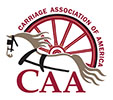Healey & Co.
New York
Circa 1910
Type:
The earliest form of “breaks” appeared in Britain sometime in the closing years of the 18th century in the form of what might now be called a “skeleton break,” intended for use only in training horses for pair or four-in-hand work. In the 1840s, breaks with the addition of a wagonette body were built, and these became known as “body breaks.”
The addition of a removable forward-facing seat behind the box seat was a later development, and breaks with this addition were sometimes called “built-up breaks.” The Healey break is built on a perch undercarriage with telegraph springs like a coach. The axle arms have Timken roller bearings, which had come into use for carriage a few years earlier.
Provenance:
The break was built for Colonel Jay Coogan of Gladstone, New Jersey, who was a keen driving enthusiast. Mr. Seabrook bought the break from Colonel Coogan in 1954. The paintwork was done by Tom Sullivan, an English coachpainter, in the Seabrook workshop in 1972.
Builder:
The firm of Healey & Co. was started in 1849 by William Williams. He was awarded a Gold Medal for work exhibited at the American Institute Fair in 1850. Afterwards, William Healey became a partner, and the firm then became Healey, Williams & Co. About 1880, a new factory was built on West 43rd Street, New York. This was a six-story building with a large elevator for transferring carriages to the different departments. There was also a repository on Broadway. The firm became Healey & Co. in the 1890s and remained one of the leading builders of high-class carriages in New York City. They built the “Arrow” coach for the Ladies Four-in-Hand Driving Club of New York in 1901.

